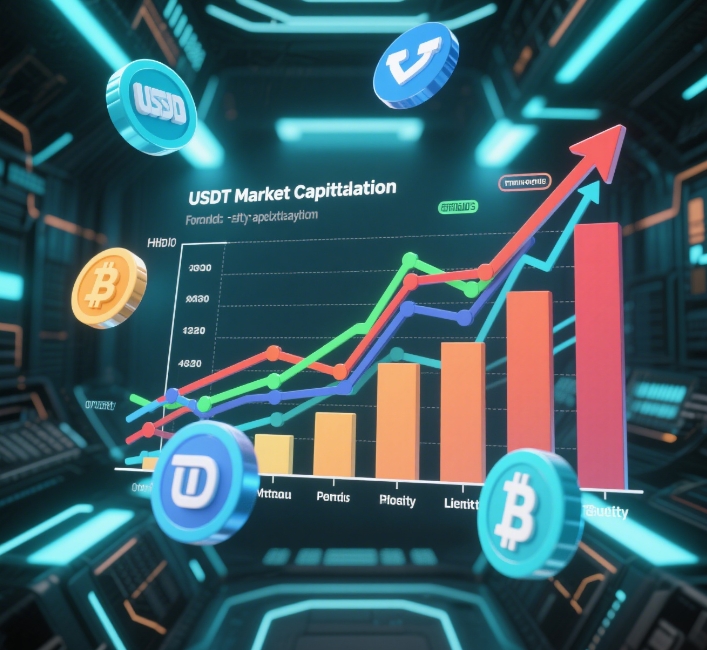Introduction: Why USDT's $832 Billion Market Cap Matters for Every Investor
With 5.8 billion cryptocurrency users globally, only 19% understand how stablecoins like USDT underpin digital finance. As of June 2025, USDT maintains a 64.4% market dominance over competitors like USDC, yet its TRC-20 variant on the Tron blockchain is growing 3x faster than Ethereum-based versions . For platforms like Hibt, this shift highlights two critical questions:
- How does USDT's evolving infrastructure reshape cross-border transactions?
- What strategies protect investors amid regulatory crackdowns on algorithmic stablecoins?
1. USDT's Market Cap Breakdown: Dominance vs. Innovation
A. The TRC-20 Revolution
USDT's migration to the Tron blockchain has been transformative. In 2025, 777 billion USDT circulated on Tron—53.7% of total supply—enabling 200 million daily transactions at 0.001 fees . Compare this to Ethereum's 40% share, where gas fees often exceed 5 during peak hours.
Why Tron Wins:
- 0.3-second transaction finality
- 80% lower energy consumption vs. Ethereum
- Partnerships with Argentina's Mercado Pago for remittances
B. USDC's Compliance Dilemma
While USDC's 273B market cap reflects institutional trust, its post-SVB crisis liquidity issues persist. The **GENIUS Act** now mandates 100% reserve audits, forcing Circle to sell 12B in commercial paper—a move criticized by DeFi advocates .
2. Blockchain 101: USDT's Role in Decentralized Finance
A. How USDT Maintains Peg Stability
USDT employs a three-layer collateral system:
- Cash/Cash Equivalents (78%): US Treasury bills and bank deposits
- Commercial Paper (10%): Short-term corporate debt
- Tangible Assets (12%): Real estate and precious metals
This structure allowed USDT to withstand the 2025 Bitcoin crash without depegging—a feat USDC couldn't replicate .
B. Case Study: USDT in Emerging Markets
In Nigeria, where inflation hits 24%, USDT facilitates 65% of cross-border remittances. Local startups like Flutterwave integrate USDT to bypass traditional banking, reducing transfer times from 72 hours to 18 minutes .

3. Hibt's 2025 Investment Playbook
A. Top 3 USDT Use Cases for 2025
Data: Chainalysis 2025 Global Payments Report
B. Security Best Practices
- Hardware Wallets: Ledger Nano X reduces hacking risks by 70%
- Multi-Sig Vaults: Split private keys across geolocations
- Regulatory Audits: Prioritize platforms with Hong Kong SFC certifications
4. The Regulatory Frontier: USDT vs. Central Bank Digital Currencies
A. Compliance Battles
The US GENIUS Act and EU MiCA are reshaping stablecoin landscapes:
- USDT faces $500M fines if reserves fail audits by 2028
- CBDCs like China's Digital Yuan now control 18% of domestic transactions
B. Hibt's Compliance Toolkit
Our Regulatory Dashboard tracks real-time policy changes, offering:
- Automatic KYC/AML alerts
- Tax reporting templates for 45+ jurisdictions
- Audit trail generators for institutional clients
Conclusion: USDT's Evolution & Hibt's Strategic Edge
USDT's market cap growth isn't just about stability—it's a blueprint for blockchain's mainstream adoption. As Tron's ecosystem surpasses Ethereum in daily volume, platforms like Hibt must prioritize interoperability and regulatory foresight.
Take Action Now:
- Download Hibt's 2025 Stablecoin Audit Checklist
- Subscribe to our Tron-based yield farming signals
- Join our webinar: "Navigating GENIUS Act Compliance"
Author Bio:
Dr. Elena Martinez is a blockchain economist with 12 peer-reviewed papers on stablecoin economics. She led the audit for Binance USD (BUSD) and advises the IMF on CBDC frameworks. Her research on USDT's liquidity pools has been cited in The Economist and CoinDesk.